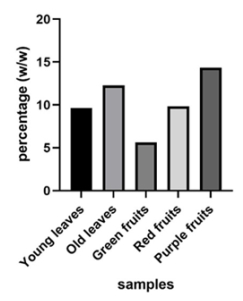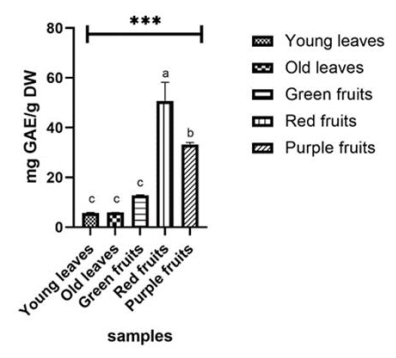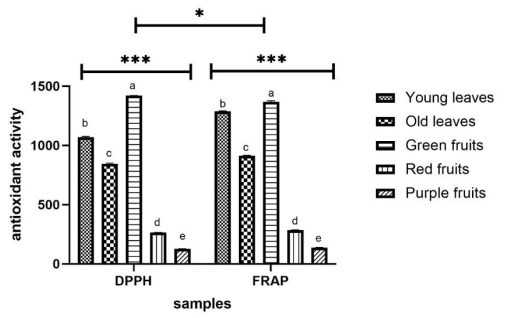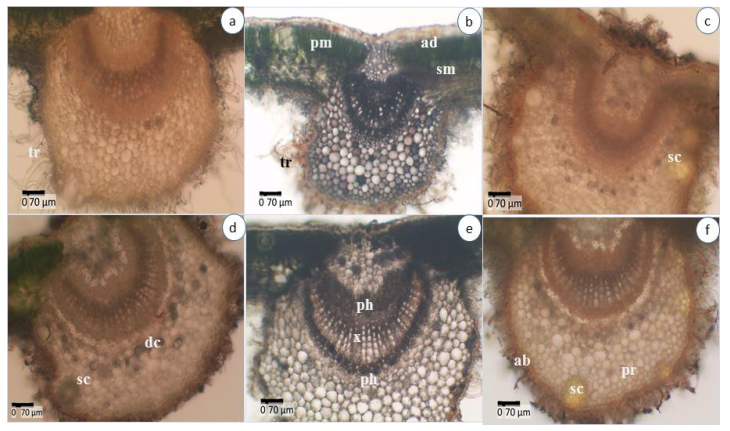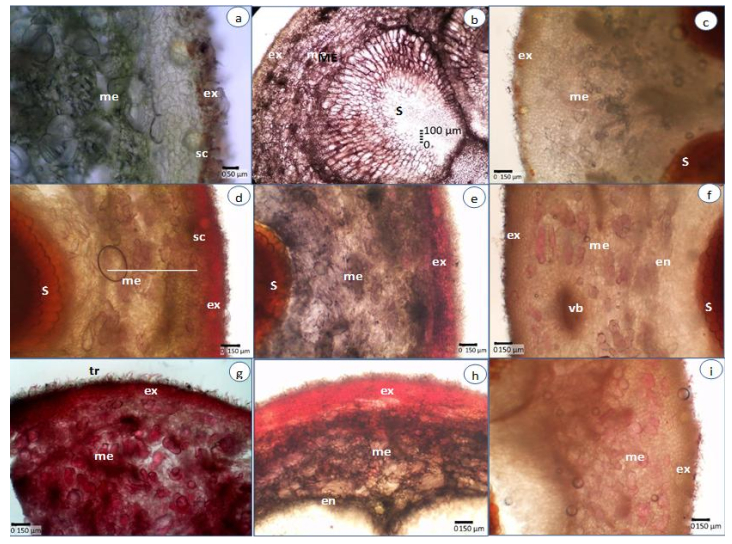1.
Introduction
Rhodomyrtus tomentosa (Aiton.) Hassk. also known as rose myrtle, is an evergreen shrub endemic that belongs to the Myrtaceae family, native to southern and southeastern Asia, from India, east to southern China, the Philippines, and south to Malaysia, Kalimantan and Sulawesi (Indonesia). It grows in abundance with rose–pink flowers and dark–purple edible bell–shaped fruits. The nature of its leaves, which have a glossy green appearance on the upper side of the leave and a dense, soft, hairy appearance on the underside grows up to a length of 12 ft, with 3 trunks from the base [1]. It has been used as a remedy to treat urinary tract infections in traditional medicine [2]. In addition, the roots and leaves of R. tomentosa were traditionally used to treat diarrhea, wounds, stomach problems, and as a postpartum tonic. This edible blueberry–like fruit contains sugars, vitamins, and minerals rich in antioxidants and is capable of lowering cholesterol levels due to its high concentration of chemical compounds [3].
Free radicals are reactive molecules that contribute to oxidative stress. They are responsible for various ailments, such as cardiovascular diseases, renal and pulmonary disorders, cancer, gastrointestinal diseases, and diabetes. The human body has many pathways to combat oxidative stress by generating antioxidant compounds, either naturally produced in situ or supplied externally by supplements or foods. Therefore, antioxidant compounds can be improved immune response and reduce the risk of degenerative diseases [4]. Plants abundantly contain natural antioxidants such as phenol, flavonoids, tannin, alkaloids which are capable of neutralizing free radicals and other metabolites [4]. Recent studies showed that natural antioxidant performs better than synthetic, specifically in terms of safety in long–term use. Synthetic antioxidants, such as butylated hydroxytoluene (BHT) and butylated hydroxyanisole (BHA), were reported to alter enzyme activity and lipid concentration and have carcinogenic consequences. In addition, their long–term use can lead to chronic health problems [5].
Histochemical analysis of the leaves and fruits during the developmental phase provides an idea of the spatial distribution of metabolites that affect color and flavor during plant organ development [6]. However, this kind of study has rarely been conducted. Classes of secondary metabolites, such as phenolic, tannins, sesquiterpenes, and triterpenes, can be detected using specific reagents applied in hand–made fresh sections of plant tissues [6]. In addition, observations performed under a light microscope of these fresh histochemical samples allow quick monitoring of plant organs, such as the localization of flavonoids and phenols in R. tomentosa leaves and fruits at various ages.
The potentials of R. tomentosa as a new source of health–promoting compounds such as dietary fibers, essential fatty acids, and phenolic compounds were highlighted based on the results of these subsequent studies. Previously, a total of 19 phenolic compounds were identified, with stilbenes and ellagitannins being the most abundant, followed by anthocyanins, flavonols, and gallic acid. Piceatannol, a prospective component of stilbene that promotes health, was discovered as the primary phenolic compound found in R. tomentosa fruits [7]. It was also found that flavonoids have a high antioxidant capacity by scavenging oxygen free radicals, promoting anti–oxidase, or inhibiting oxidative enzymes [7,8]. Previous studies on R. tomentosa fruits focused on assessing nutritional, phytochemical profile, and other bioactivities. However, only a few reported the antioxidant activity and histochemical analysis of R. tomentosa leaves and fruits at various ages. In this study, these two factors were used to determine the secondary metabolite content of the leaves and fruit of R. tomentosa. It also aims to provide clear information on which part of the organ potentially develops as an antioxidant source.
2.
Materials and methods
2.1. Plant materials
The 2nd and 10th leaves from the tip shoot (as young and old leaves), the green, red, and purple fruits of R. tomentosa were collected from the wild area in Banjarbaru, South Kalimantan, Indonesia (3°29′0″S, 114°52′0″E) (Figure 1). R. tomentosa is about 1–2 m high of evergreen shrub. It often has branchlets with grayish tomentose. The leaves are often opposite and blade elliptic to obovate. The flowers have 5 hypanthium obovoid sepals with gray tomentose. Obovate petals and red stamens can be also found in the flowers. R. tomentosa fruits are urceolate black berry [1]. Three replicate samples of leaves and fruit were collected from three different individual plants for histochemical analysis. The sample plant identification was conducted by Herbarium Bogoriense, Indonesian Institute of Sciences, Bogor, Indonesia with certificate number 1007/IPH.1.01/If.07/IX/2020.
2.2. Histochemical analysis
Fresh transversal sections of leaves and fruits were prepared from different physiological stages for histochemical analysis. Different sections were treated with a dilute 10% aqueous acidic FeCl3 (Sigma–Aldrich, Germany) solution containing a small amount of Na2CO3 (Sigma–Aldrich, Germany) solution mounted in clove oil and examined under a microscope for the presence of phenolic compounds, which was identified in dark green or black color in the tissues [9].
Wilson's reagent was used to identify flavonoid compounds. Each section was soaked in citric acid:boric (Prolabo) (5:5 w/w) in 100 mL absolute ethanol for 15 mins, mounted in glycerine–water and examined under a light microscope (Olympus, Tokyo, Japan). The presence of flavonoids was indicated by the yellow color [10].
2.3. Crude extract preparation for antioxidant analysis
The 2nd–6th young and 7th–12th old leaves were collected from the tip shoot of R. tomentosa, while the green, red, and purple fruits were dried in an oven at 40 ℃ before being powdered at room temperature. About 500 g of each powdered material was macerated using 1000 mL of ethanol (SmartLab, Indonesia) for 24 hours. Subsequently, the solvent was discarded and replaced every 24 hours and this procedure was repeated three times [11]. Finally, extracts from the same samples were pooled, thoroughly mixed, filtered to remove cell debris, and then dried using a rotary evaporator. The yield of extract was calculated by this equation, namely (weight of ethanol extract/weight of dried leaves/fruits) × 100%.
2.4. Antioxidant analysis
The DPPH (2, 2–diphenyl picrylhydrazyl) radical scavenging activity analysis was modified from the study of Purwakusumah et al. [12]. The ethanol extracts were diluted to the desired concentration with absolute methanol (SmartLab, Indonesia). Afterward, approximately 2 mL of the sample was mixed with 2 mL of 0.17 mM DPPH (Sigma–Aldrich, Germany). The mixture was then incubated in the dark for 30 mins at room temperature, while the absorbance at 516 nm was recorded using a UV/Vis spectrophotometer (UV/Vis Spectrophotometer, Genesystm 10 Series, USA). The free radical scavenging activity was also quantified in μmol Trolox (Sigma–Aldrich, Germany) equivalents per g dry weight (DW) (μmol TE/g).
The FRAP (Ferric Reducing Antioxidant Power) analysis was performed using a modified technique by Zhao et al. [3]. The working solution was 25 mL of 300 mM acetate buffer (3.1 g of CH3COONa.3H2O (Merck, Germany) and 16 mL of CH3COOH per liter of a buffer solution with pH 3.6, 2.5 mL of 10 mM 2, 4, 6–tri (2–pyridyl)–s triazine (TPTZ) (Sigma–Aldrich, Germany) (3.12 g TPTZ per liter of 40 mM HCl), and 2.5 mL of 20 mM FeCl3.6H2O (Merck, Germany) solutions, which were incubated at 37 ℃ for 10 mins before being used. Absolute methanol (SmartLab, Indonesia) was also used to dilute ethanol extracts to a suitable concentration, and 1 mL of the diluted extract reacted with 3 mL of the working solution for 15 mins in the dark at room temperature. The absorbance was measured at 598 nm using a UV/Vis Spectrophotometer (UV/Vis Spectrophotometer, Genesystm 10 Series, USA). In addition, a standard curve was produced using Trolox, and the results were represented as μmol Trolox equivalents (TE) per g dry weight of the samples (μmol TE/g).
2.5. Total phenolic content (TPC)
The TPC analysis was performed following a modified procedure from Folin Ciocalteau method [5]. First, the sample extract was dissolved in methanol (1 mg/mL), and a total of 100 µL of the solution was mixed with 500 µL Folin Ciocalteau (Sigma–Aldrich, Germany). After incubating the mixed solution at room temperature for 10 mins, it was mixed with 1.5 mL of 20% Na2CO3. The mixture was diluted with aquadest up to 10 mL, then heated for 1 min in a water bath at 40 ℃ and cooled down in the dark. The sample's absorbance was measured with a UV/Vis spectrophotometer (spectrophotometer UV 1800–Shimadzu, Japan) at 760 nm. The total phenol content was determined using the standard gallate acid (Merck, Germany) at mg GAE/g dry weight.
2.6. Total flavonoids content (TFC)
TFC was determined using a Vis spectrophotometer [5]. An amount of 500 µL of the sample extract (1 mg/mL) was mixed with 300 µL of 5% NaNO2 (Merck, Germany), and incubated at room temperature for 5 mins before being mixed with 600 µL and 10% AlCl3 (Sigma–Aldrich, Germany) and incubated at room temperature for another 5 mins. The sample was then mixed with 2 mL and 1 M of NaOH (Sigma–Aldrich, Germany) and added with aquabidest to reach a volume of 10 mL. The absorbance was measured at 510 nm wavelength with the same technique as the previous measurement. Finally, the total flavonoids content was determined using a standard curve of Quercetin (Sigma–Aldrich, Germany) at mg QE/g dry weight.
2.7. Statistical analysis
Mean values and standard deviation (mean ± SD) were determined from three replications. The quantitative data were statistically analyzed using one–way analysis of variance with significant differences set at p < 0.05 using Microsoft Excel® and IBM SPSS statistics 21. The analysis of variance was followed by an LSD post hoc test when a different result was observed.
3.
Results and discussion
3.1. Yield, TPC, TFC, and antioxidant capacity of ethanol extracts
Ethanol extracts of purple fruits were observed as the highest yield at 14.35% w/w, followed by old leaves at 12.296% w/w, while the green fruits were the lowest, namely 5.63% w/w (Figure 2). Yields of the ethanol extracts of various R. tomentosa species from previous studies were comparable to this study ranging from 2.9% to 16.2% [11]. The following are the yield extract values, namely 1.6 g leaves with 16.2 % DW, 7.6 g stem with 9.8% DW, 0.4 g twig with 9.7% DW, and 1.5 g fruit with 2.9% DW. Interestingly, R. tomentosa fruits produced a larger yield in this study than in previous studies. The discrepancy could be attributable to the different extraction period, collection time, and location (samples from previous studies were collected nearby Samarinda City), despite the plants being collected from the same island, Kalimantan.
The variation of the TPC results was high and the value of the samples ranged from 5.792 ± 0.14 to 50.772 ± 7.46 mg GAE/g DW depending on the organ sources. The highest TPC value was obtained from red fruits ethanol extract 50.772 ± 7.46 mg GAE/g DW, followed by purple fruits 33.312 ± 0.70 mg GAE/g DW, while the lowest value was from young and old leaves with ethanol extracts of 5.792 ± 0.14 and 5.830 ± 0.06 mg GAE/g DW (Figure 3). Purple fruits had significantly higher TPC than those reported by Huang et al. [13], and Zhao et al. [3], but lower than Lai et al. [14], namely 49.21 ± 0.35 mg GAE/g DW.
The TFC of the leaves and fruits from R. tomentosa varied from 67.115 ± 2.57 to 96.375 ± 3.96 mg QE/g DW. The highest value observed in the young leaves and green fruits of the ethanol extract was 96.375 ± 3.96 and 95.731 ± 5.42 mg QE/g DW, respectively. This was followed by red fruits of 88.125 ± 2.72 mg QE/g DW, while the purple fruits' lowest value was 67.115 ± 2.57 mg QE/g DW (Figure 4). The total flavonoids contents of R. tomentosa purple fruit were higher than the results reported by Wu et al. [8] 5.21 ± 0.20 mg RE/g DW in air–dried fruit and by Zhao et al. [3] 8.52 to 15.51 mg RE/g DW. Lai et al. [15] also investigated the effects of maturity stage and environmental factors on the number of total flavonoids in R. tomentosa in Vietnam and found 1.52 ± 0.14 mg QE/g DW of the total flavonol.
Flavonoids have been found in a variety of fruits and vegetables, including chili and pepper (83–1163 mg/kg DW), 675.5 mg/kg DW angular loofah, 1128.2 mg/kg DW guava, 1264 mg/kg DW papaya shoots, 806 mg/kg DW bilimbi, 2720 mg/kg DW onion leaves, 157–263 mg/kg FW cranberry, 184 mg/kg FW bog whortleberry, 74–146 mg/kg FW lingonberry, and 100–102 mg/kg FW crowberry, and 18.2–38.3 mg/ 100 g FW black currant [8]. In this study, the extract from R. tomentosa fruits was rich in flavonoids, having more than three times TFC than cranberries and even more than other berries and vegetables.
It was found that the impact of maturity stages on TPC of the R. tomentosa fruit during maturation decreased [15]. It was revealed that most individual phenolic contents behaved in the same way within each family. Other fruits such as Brazilian cherry Eugenia uniflora L. (Myrtaceae) also showed a similar trend [16]. Both studies showed that maturity affects the accumulation and the profile of the phenolic contents in fruits. The fruit of R tomentosa displays a green color that changes into a red or purple during the maturation process, suggesting a change in this compound's and phenolic profiles. Furthermore, environmental parameters such as light, soil type, and stress factors influence the amount of this compound in fruits [16,17].
DPPH and FRAP analyses were performed to analyze all samples' antioxidant properties. The DPPH radical scavenging capacity and FRAP of R. tomentosa leaves and fruits ranged from 127.49 ± 0.57 to 1419.75 ± 3.48 µmol TE/g DW and from 138.38 ± 1.13 to 1367.59 ± 9.12 µmol TE/g DW (Figure 4). This result indicates that the ethanol extracts of leaves and fruits have the same antioxidant characteristics in reduced capacity and free radical scavenging capacity.
In general, the antioxidant capacity of R. tomentosa measured by the DPPH method showed a comparable proportion when evaluated using FRAP (Figure 5). This was found in the ethanol extracts of the green fruits, which had the highest DPPH radical scavenging capacity and FRAP with values of 1419.75 ± 3.48 and 1367.59 ± 9.12 μmol TE/g DW, respectively. The lowest result was observed in the purple fruits, namely 127.49 ± 0.57 and 138.38 ± 1.13 μmol TE/g DW. This was almost four times lower than the activity reported by Lai et al. [14] 431.17 ± 14.5 µmol TE/g DW and higher than those from the study of Wu et al., [8], which were measured in a variety of consumed fruits such as grape, kiwifruit, oranges, apples, mangoes, blueberries, bananas, and blackberries 8.79–92.60 µmol TE/g DW [17].
The DPPH radical scavenging mechanism was used to analyze the antioxidant activity of R. tomentosa extracts. DPPH is a free radical compound that has been frequently used to assess the ability of various types of samples of free radicals scavenging activity [11]. The method has the advantages of being quick, simple, and economical and providing firsthand information on the overall antioxidant capacity of the test system [11]. In the FRAP analysis, a compound's reducing capacity may serve as a significant indicator of its potential antioxidant activity. The transformation of Fe3+–Fe2+ in the presence of R. tomentosa extract was analyzed to determine its reductive capacity [2]. According to FRAP analysis from Maskam et al. [2], R. tomentosa extracts exhibit high antioxidant activity. The results by Lavanya et al. [18] also showed that the extract has a significant reducing ability, namely 2.7 and 3.0 times more than gallic and ellagic acids, respectively. Therefore, the extract demonstrated good ferrous ions chelating activity.
The highest amounts of flavonoid compounds were found in the young leaves and green fruit of R. tomentosa, namely 95.731 ± 5.42 and 96.375 ± 3.96 mg QE/g DW resulting in a high antioxidant activity of 1419.75 ± 3.48 and 1069.38 ± 6.57 μmol TE/g DW. This was substantially six times higher than the values found in the study of Zhao et al. [3], namely 15.51 ± 0.20 mg RE/g DW and 303.20 ± 49.31 μmol TE/g DW of the fruits. The number of phenolic compounds found in the R. tomentosa fruit [14] was 49.21 mg GAE/g DW with antioxidant activity of 431.17 μmol TE/g DW. Flavonoids act as antioxidants because they are effective reductors, preventing oxidative stress. They can efficiently capture oxygen–reactive compounds, as well as reduce and chelate ferric ions, which catalyze lipid peroxidation [19]. Phenolic compounds are important antioxidants because of their redox characteristics, which act as hydrogen donors, singlet oxygen quenchers, reducing agents, metal binders, and free radical scavengers. They are classified into simple phenolic, phenolic acids, hydroxycinnamic acid derivatives, and flavonoids [7,20]. According to Zhao [1] the strong antioxidant activity was considered to be closely related to the presence of high total flavonoid and total phenolic contents in leaves and fruits R. tomentosa extract. The results by Neves et al. [21] also showed that immature fruits showed higher ethylene biosynthesis that induced higher respiration rate and metabolic activity. The higher phenolic content of immature fruit was associated to high levels of antioxidant activity of açai fruit (Euterpe oleracea Mart., Euterpe precatoria Mart). Fawole et al. [22] also recorded the reduction in antioxidant activities during pomegranate fruit development may be associated with apparent decrease in quantity of polyphenols in the fruit juice. Although anthocyanins are known as antioxidant compounds, their increase during fruit development constituted only small proportion of total flavonoids or phenolics contents in fruit juice, hence the change in flavonoids a much more significant influence than anthocyanins on juice antioxidant capacity.
The antioxidant activity of the green fruits and young leaves ethanol extract was higher than the old leaves, red and purple fruits. This is because green fruits contain more flavonoids than the others (Figure 4). In addition, antioxidant activity increases with increasing levels of these compounds.
3.2. Histochemical analysis for location of secondary metabolites
The histochemical and phytochemical analyses of R. tomentosa leaves and fruits showed the presence of compounds with known medicinal properties such as flavonoids and phenolic scattered throughout the tissues of those organs. The histochemical analysis demonstrated the presence of these two compounds in the leaves and fruits of R. tomentosa (Figures 6 and 7). They can be found in specific areas or practically all across plant tissue. According to histochemical analysis, flavonoids produce a yellow color when stained with Wilson's reagent, while phenols are stained with FeCl3, they turn black. Phenolic was found in the adaxial and abaxial epidermis, mesophyll, xylem, phloem, parenchymal midrib, secretory cavity, trichome, and druse leaves (Table 1) (Figure 6b, e). It was discovered in the exocarp, mesocarp, endocarp, secretory cavity, xylem, phloem, trichome, and the seed of green, red, and purple fruits (Table 1) (Figure 7b, e, h). Flavonoid was detected in the epidermis, mesophyll, vascular bundles, secretory cavity, trichome, and parenchymal midrib of R. tomentosa leaves (Table 1) (Figure 6c, f), whereas it was found in the exocarp, mesocarp, and endocarp secretory cavity, xylem, phloem, trichome, and the seed of R. tomentosa fruits (Table 1) (Figure 7c, f, i).
According to [5], flavonoids were found in the vacuole, mesophyll, glandular trichomes, exocarp, mesocarp, and endocarp fruits of Acalypha indica L. and Acalypha wilkesiana Muell. Arg. The results by Ferreira et al. showed that this same compound along with tannin, and terpenoid were found in the epidermis, parenchyma, and secretory cavities of Psidium guineense Sw. (Myrtaceae). Flavonoids are common in most plant species yet distinctive to many other categories. They are relatively straightforward to recognize, and can be employed as chemical markers in taxonomic classification [19].
4.
Conclusions
In this study showed the ethanol extracts from leaves and fruits of R. tomentosa exhibit good antioxidant ability on the DPPH radical scavenging potential and FRAP. The antioxidant capacity of R. tomentosa measured by the DPPH method showed a comparable proportion when evaluated using FRAP. This was found in the ethanol extracts of the green fruits and young leaves, which had the highest DPPH radical scavenging capacity and FRAP. This is because green fruits contain more flavonoids than the others but the highest phenolic value was obtained from red fruits. In addition, antioxidant activity increases with increasing levels of flavonoid compounds. Therefore, the results of this study showed that the positive relationship between total flavonoids content and antioxidant activities in this plant. The green fruits and young leaves of R. tomentosa have a potential antioxidant effect, implying that they have the potential to come as a source of health–promoting compounds. The histochemical and phytochemical studies also verified the presence of pharmaceutically active secondary metabolites, primarily flavonoids and phenolic, which made R. tomentosa a significant antioxidant.
Acknowledgments
The authors express their gratitude to the reviewers for their insightful remarks and suggestions in improving this work and to Dewi Anggraeni for helping in the statistical analysis. The authors are also grateful to the LPDP (Lembaga Pengelola Dana Pendidikan) and the Ministry of Research, Technology, and Higher Education of the Republic of Indonesia for financially supporting this research through the BUDI DN (Beasiswa Unggulan Dosen Indonesia) scholarship (Number: KET–976/LPDP.4/2021). We would like to thank Universitas Gadjah Mada, Yogyakarta, Indonesia for supporting this research through RTA grants 2022.
Conflict of interest
The authors declare that there is no conflict of interest.










 DownLoad:
DownLoad:
